How To Page At The Register
As a marketer, you probably like to retrieve you understand your prospects well — who they are, how they behave, etc. So if one of them visited your website or signup folio, what do you remember they'd do next?
Probably register for your service, right?
That'due south not e'er the case, equally one make constitute out. For them, something between that CTA and their "thank you" page was causing the business organisation to lose nearly a quarter of its potential customers.
There was a problem with their sign-up page.
What is a signup page?
Signup pages, also known every bit "registration pages," aren't nonetheless. Some are PPC post-click landing pages; others are linked to the homepage via navigation – some even are the homepage. Despite their differences, they all share the same goal: generate sign-ups for a service.
In many cases, the signup folio is the last step in a business's conversion funnel. It'due south where prospects navigate afterwards they've evaluated a brand and decided its service offers what they demand.
Because of that, signup pages focus less on persuading the prospect to convert and more on minimizing the friction involved in doing information technology. That focus on usability means other traditional post-click landing folio elements like social proof, testimonials, and attention-grabbing media take a backseat.
Just look at Shopify'south signup page below, which pops upward over the homepage one time yous click "get started."
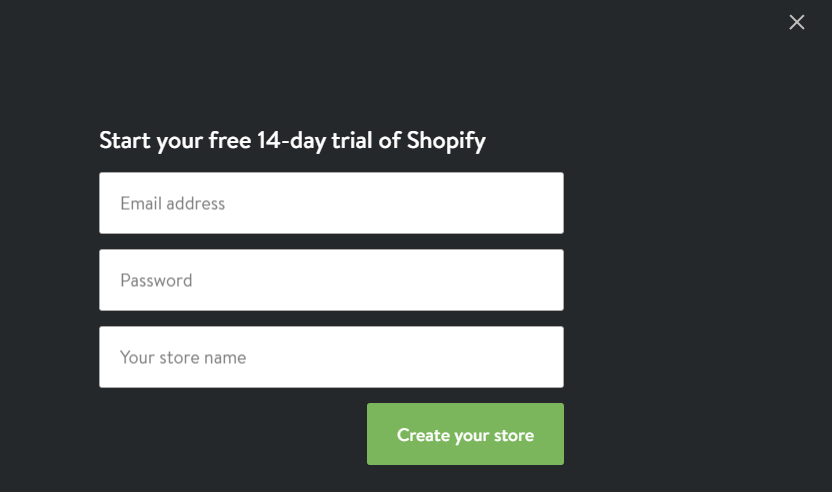
It's really just a brusque form. And, as you'll see a little afterward, nigh signup pages are built the same way, featuring naught more than a headline, a few form fields, and a phone call-to-activeness.
Merely just because many are designed that fashion doesn't hateful it'south the right style. Creating a successful signup page is well-nigh more than eliminating distractions and reducing course fields. The task is two-fold.
To generate maximum signups, you accept to minimize the steps involved in registering, and at the aforementioned fourth dimension, brand the most of the few elements yous practice use. Here are some tips and insights from the experts.
ane. Use a benefit-oriented headline
By the fourth dimension a prospect arrives at your signup page, in most cases, they've already evaluated your service and determined information technology suits their needs. Simply, does that mean y'all shouldn't remind them why they're there?
Below, Copyblogger uses a social-proof-blimp headline to convince users to sign up, and above, Shopify reminds prospects their trial is free for fourteen days.
Simple is good, only if you have the room to reinforce your USP with a headline, do it. Chances are it'll take a more positive impact on conversions than negative.
2. Make all your fields required
This tip is less about requiring your visitors to complete your form and more about making certain you've picked the right fields. By that we mean, if you've determined a form field is optional, you don't demand that piece of information to sign the prospect upwardly.
For example, a service like Groupon needs to know your location at signup to offering you relevant deals and coupons. But, location isn't a crucial piece of information for Instapage to know about its customers, which is why we don't ask for information technology during registration.
If yous don't really demand to know your prospect's visitor, their position, or how many employees they have, then don't ask. The less work they need to do, the amend.
Grade fields to consider
Some class fields to consider consolidating/getting rid of:
- Username: Do your users really need a username to sign up? Or can you but ask for their electronic mail, and and then let them make up one's mind their username in one case they've logged in?
- Ostend password: This field is outdated and only necessary because of password masking, some other impractical technique.
Password masking is the technology that makes every letter of the alphabet await similar an identical bullet point when information technology's entered into a form. It gives the impression of extra security, but the only thing it really protects from is people peeking over your shoulder.
Inquire yourself: are my prospects actually creating their passwords in a crowded public setting? Not likely.
Instead of using a "confirm password" field, allow users to see what they're typing by unmasking the original "password" field, or using a "show/hide" feature, the mode MailChimp does on their signup page:
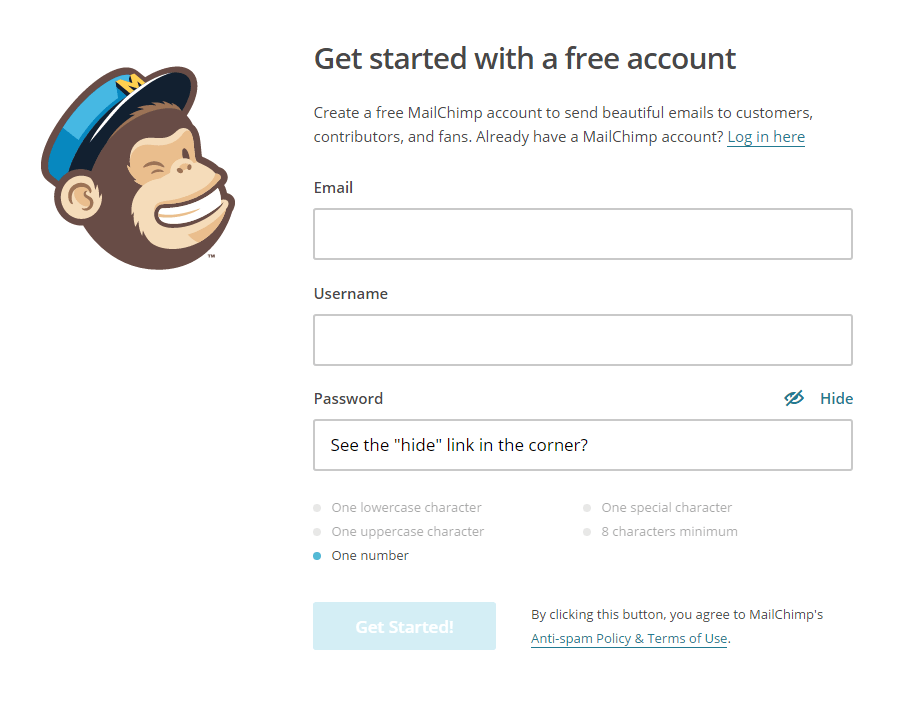
- First and final name: Consider consolidating first name and terminal name into one "full proper name" field. Or, just enquire for commencement name. Heck, maybe even recollect about getting rid of it birthday.
In several examples below (Buffer, Asana, Crazy Egg), signup pages don't enquire for name immediately, but allow their converted customers input details once they've logged into the platform.
- User understanding: Instead of making your users click a checkbox stating they agree to your user terms, consider including a bulletin to a higher place your CTA the way LinkedIn does below. It states that past converting, the user automatically consents.
iii. If you absolutely need all that information, ask for information technology in steps
Look, sometimes you really practice need a lot of information to annals a new user. Signups that require on-the-spot payment necessitate long forms to capture sensitive data like billing address and credit bill of fare number. When that happens, consider breaking the registration process down into multiple steps.
A report from Formstack shows that terminal yr, multi-page registration forms outperformed unmarried-page ones by more than 9%:
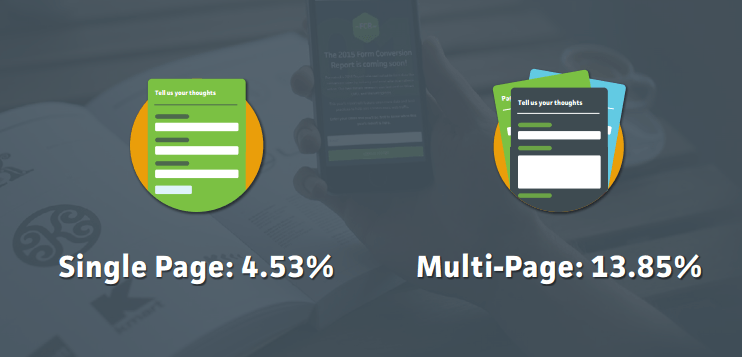
Why?
Multi-page forms make converting less overwhelming by separating the process into several brusk steps. More pages mean more space for bigger fonts, longer fields, and descriptive labels that might not fit in a shorter form. Additionally, multi-folio signups usually come with a convenient progress bar that lets users know how far along they are in registration.
Remember: if you can shorten your form by eliminating a few fields, shorten information technology. If you lot can't, don't effort to brand it appear shorter past cramming everything into a small corporeality of space. You'll only clutter your page and overwhelm your prospect.
iv. Consider using a modal window
For those with a quick sign-upwards process, like Canva, a modal window offers a few benefits.
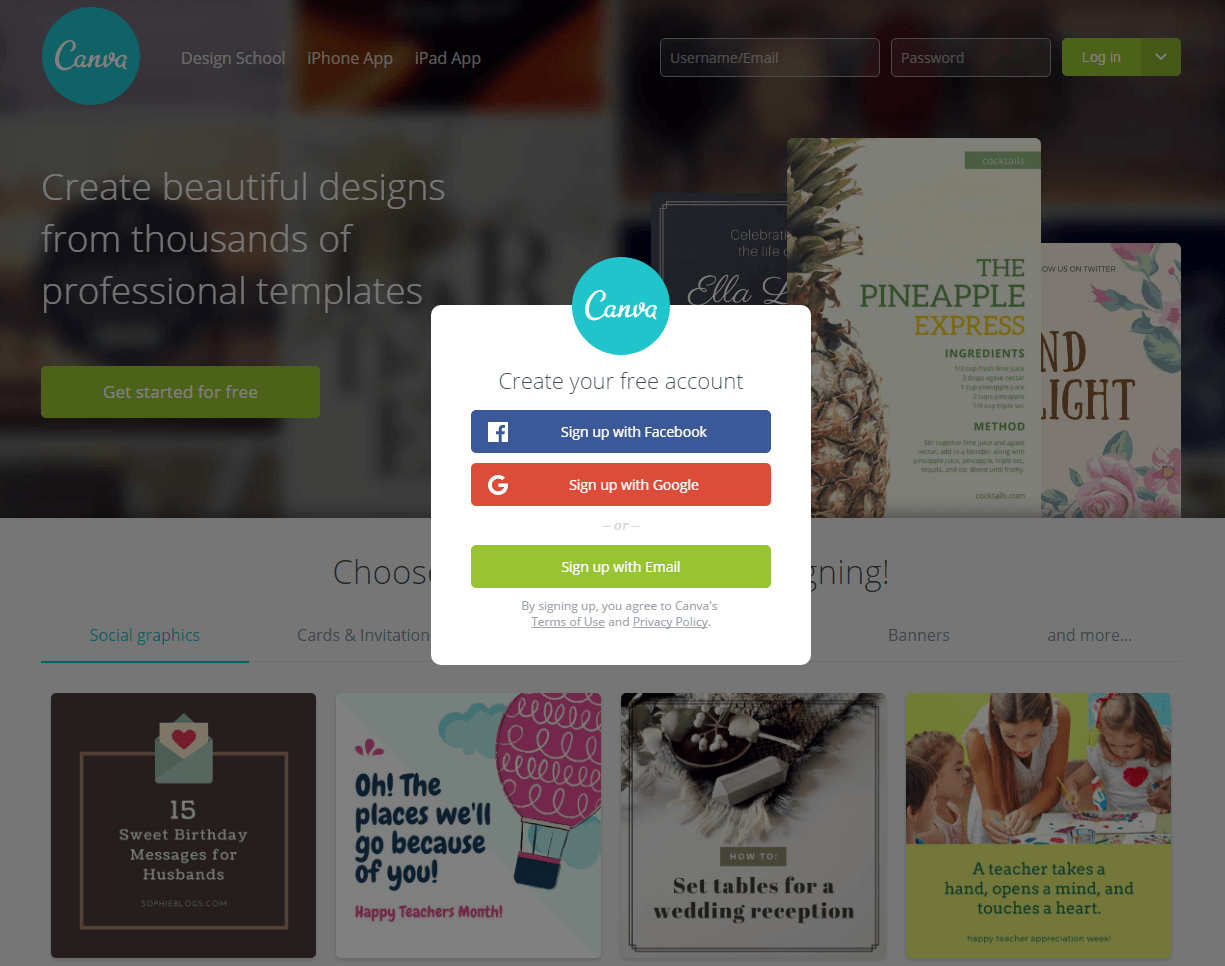
Designer, Joshua Johnson, explains why:
They overlay current content instead of taking you to a dissimilar page. Somehow that'southward just less unsettling than existence whisked away to somewhere new, which feels like an interruption. By dimming the homepage graphics and bringing upwardly a modal sign registration form, y'all get the sense that the procedure volition be quick and painless and that you'll be back to browsing in no time.
At a time when internet users are more impatient than ever, giving them the impression they'll be back to browsing in an instant is a great practice.
5. Enable social autofill
In nearly every signup page case below, you'll notice social autofill buttons. These allow users to bypass your class with a single click by importing relevant personal data they've already submitted to social networks.
Formstack plant that past including this characteristic, users were able to generate 189% higher form conversions. Additionally, 86% of people say that creating new user accounts on unlike websites is inconvenient. When your goal is to make converting as easy as possible, leveraging social autofill is a no-brainer.
6. Ditch the placeholder text
To catechumen, visitors need to know how to fill out your grade. But, using placeholder text isn't the best way to show them.

Co-ordinate to the Nielsen Norman Group, adding light greyness text to your class fields has the potential to:
- Strain users' short-term memory. When they start typing and the gray text disappears, they remember to themselves, "How many characters does my password need to have again?"
- Make your form fields invisible. Empty form fields are actually more noticeable by prospects than ones with placeholders.
- Irritate users tabbing through the course. Those quickly completing your grade using the "tab" button won't accept time to read explanational placeholder text before it disappears.
- Confuse visitors. They might mistake placeholder text for information that was automatically filled in.
To avert whatever confusion, include a label above each field that tells visitors exactly what they demand to include in it. Placeholder text will but create more friction on your registration folio.
How the pros build registration pages
At present that you know what to include on your signup page, allow's take a look at how the pros build theirs.
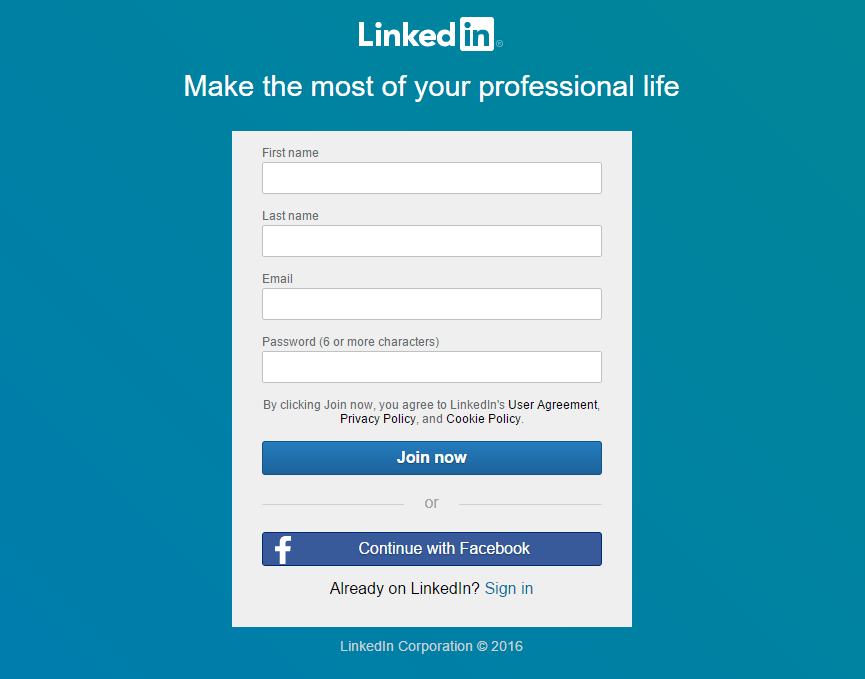
This LinkedIn signup page is of the post-click landing page variety. It's standalone, significant it'due south not continued to the company'south website via navigation — non even in the logo.
In a higher place the form, the headline could convey a stronger do good. On it, four fields keep friction low. Though, by combining first and last names into one "full proper name" field, that friction could exist fabricated even lower.
Over each text box, gray lettering lets prospects know what they're supposed to type, and in a higher place the "password" field, that label is fifty-fifty more than specific. Though, that "password" field doesn't follow best practices by displaying identical bullets for each letter the prospect types.
Additional gray lettering underneath the last form field lets visitors know that by clicking "Join At present," they concord to LinkedIn's user agreement, privacy policy, and cookie policy. That saves the prospect the actress step of having to click an opt-in box to consent.
In the call-to-activeness, the word "now" emphasizes that one time the user clicks the CTA button, they're immediately part of the network. As far equally the push button itself goes, it could popular a trivial more, don't you think? A different background or button colour might draw more attention to where the user needs to click to bring together.
Below that, a "Continue with Facebook" button streamlines the entire procedure. If you have a contour on the world'south biggest social network, click that button to permit autofill complete the course for you lot using data you've already shared with Facebook.
Copyblogger
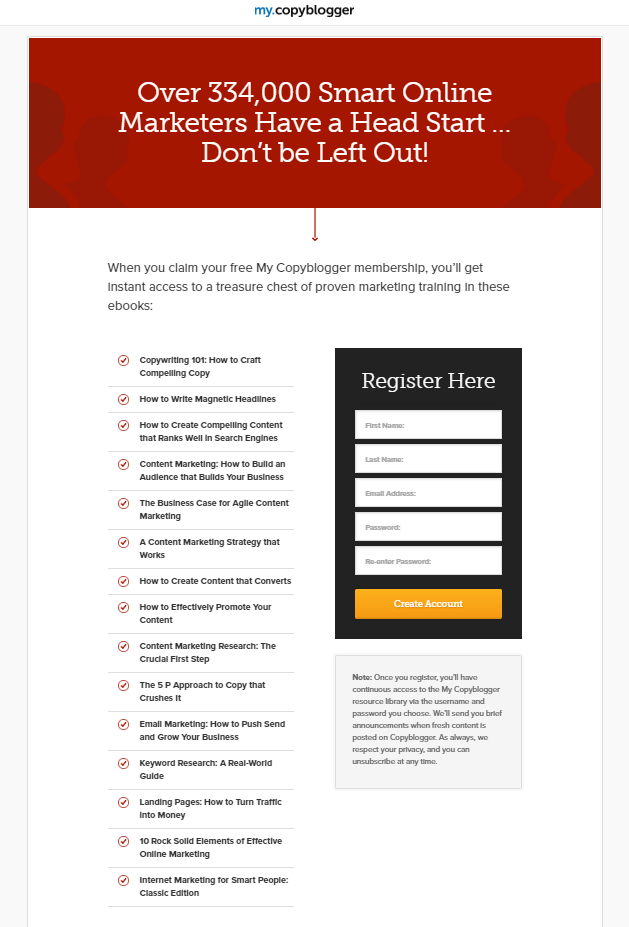
Here's a signup folio that's more merely a form. The first thing prospects are probable to notice is that giant, social-proof-filled headline. Translated, it says, "if we're adept enough for 334,000 marketers, we're good enough for you too."
It too takes advantage of a phenomenon commonly known as "FOMO," significant "fright of missing out." No one wants to miss out on getting the head start that 334,000 of their industry peers take.
Underneath that, a preview of all the free valuable content that prospects go after registering tempts them to fill out that form. The class itself, though, could be improve designed.
By eliminating the "re-enter password" field and condensing first and last name into "full name," Copyblogger could reduce the number of text boxes from 5 to 3, and, in plough, the corporeality of friction involved in signing up. In place of that "re-enter countersign" field, a show/hibernate choice can exist used to ensure accuracy when inbound a password.
To reduce friction even further, labels within each field should be positioned to a higher place instead. Right now, that greyness lettering disappears when prospects click into the text box, making information technology piece of cake for them to forget what they were typing.
Overall, while a few deficiencies in the form and a couple of outbound links might hurt conversions on this signup folio, Copyblogger's gratuitous content is as well valuable to refuse.
Crazy Egg
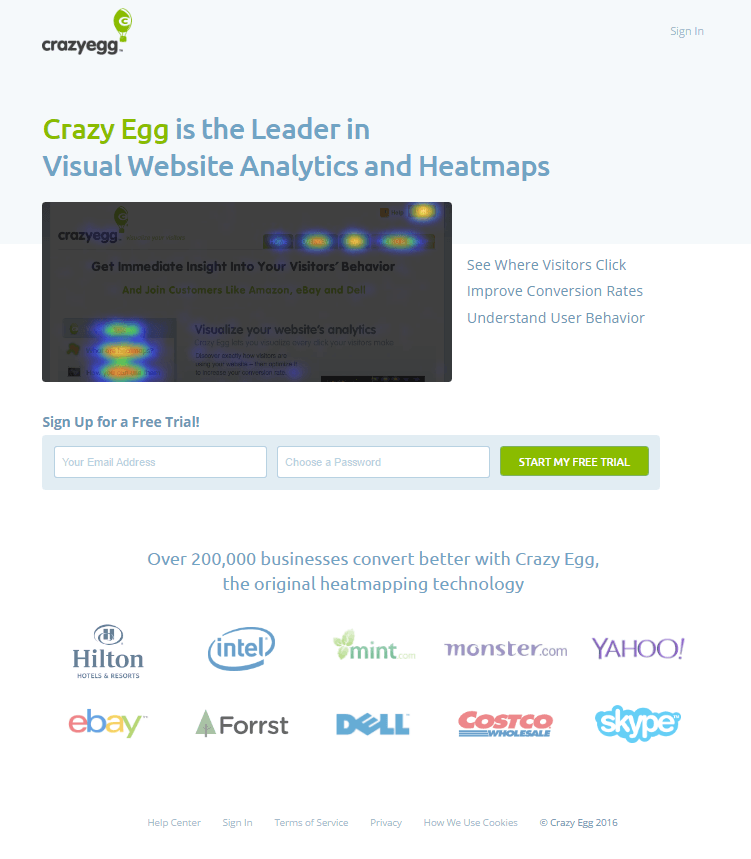
First off, a business concern calling itself "the Leader" in its industry is similar a cafè calling its coffee the earth'due south all-time. There are many who say information technology, only few who can prove it. Instead of calling yourself the best, back up your claim with a statistic or by quoting a well-known client who believes you are.
Underneath that headline is an image that previews the insight you lot gain when you use Crazy Egg, and to the right of the prototype, three lines of re-create explicate what that insight is along with what you can do with it.
On this super-brusk grade, friction is minimal. The headline emphasizes that the trial is free, the button pops on the white background, and the telephone call-to-activity is written in the kickoff person. Right now, the merely thing keeping this form from being pain-gratuitous is the distracting gray placeholder text in each field.
Below that, social proof in the form of recognizable customer logos and the text "Over 200,000 businesses catechumen better with Crazy Egg" boosts this signup page's persuasiveness.
Altogether, this folio makes converting a breeze for visitors.
Buffer
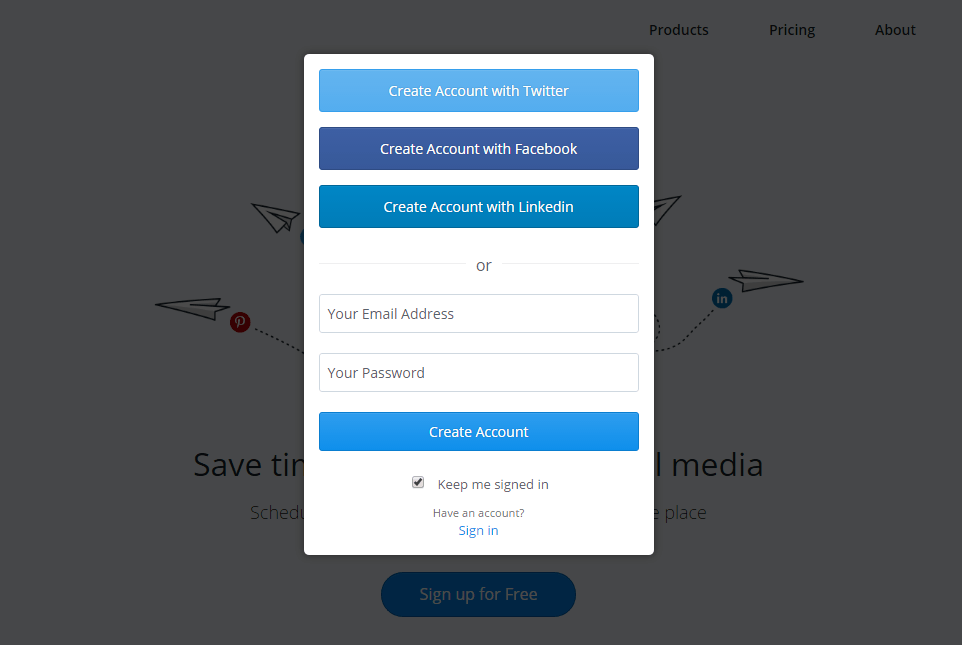
When you click the "sign up for complimentary" phone call-to-action on Buffer.com, the homepage transforms into a signup page by deploying a short pop-up class and darkening surrounding content.
On that pop-up, the conversion process is simple — click i of three social login buttons to bypass the course, or enter an e-mail address and password. Either way, friction is minimal. The only way this grade could be easier to complete? Get rid of that distracting placeholder text.
Asana
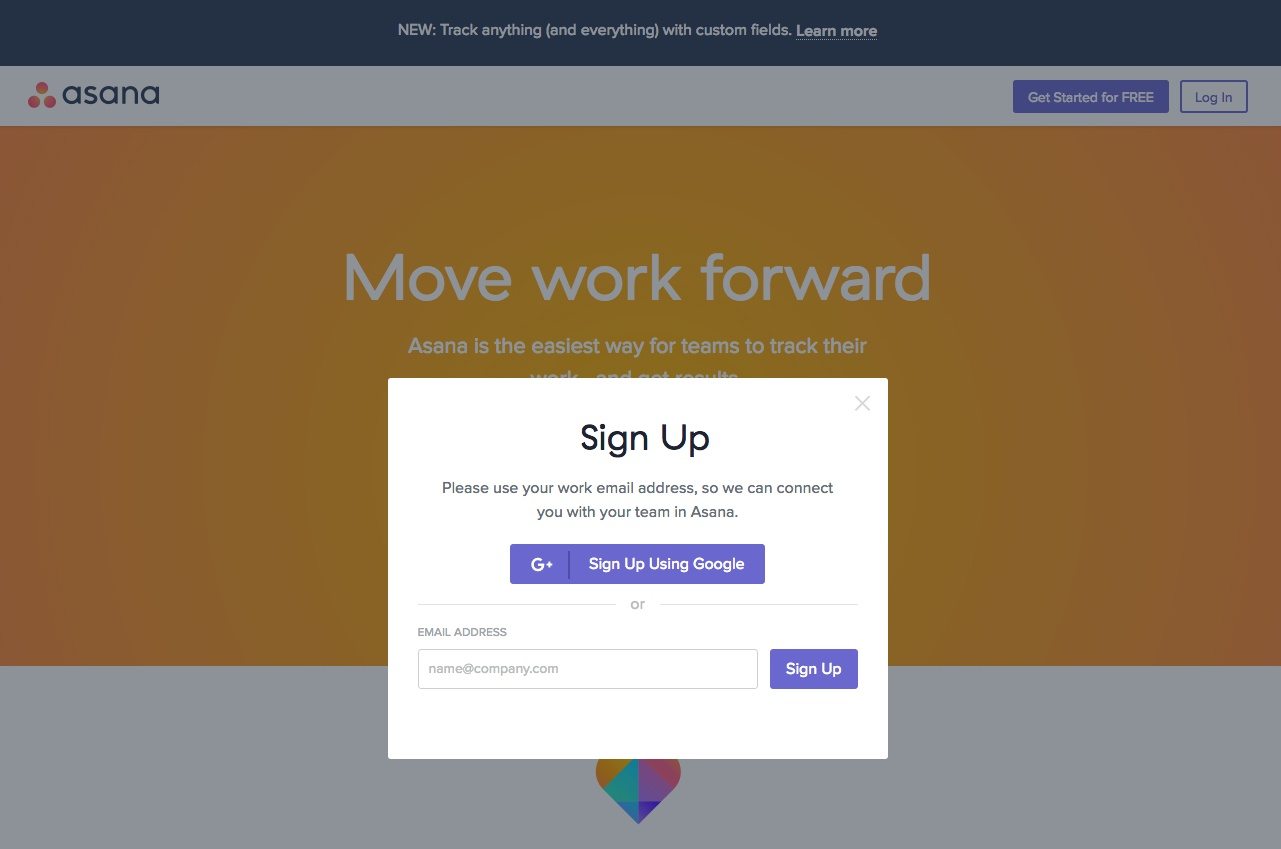
At most, signing up on this page from Asana takes two clicks. With a Google login feature, it could take as little every bit i.
A sentence in a higher place the form tells you how to consummate the form, even down to which email you should sign upwardly with.
Directly beneath that, though, a form field filled with gray placeholder text distracts the user. But will information technology deter people from signing up? Non likely. This class is nearly frictionless and easy to complete.
Begin creating an optimized signup page with Instapage, request an Instapage Enterprise demo today.
How To Page At The Register,
Source: https://instapage.com/blog/sign-up-page
Posted by: staggstholl1948.blogspot.com


0 Response to "How To Page At The Register"
Post a Comment